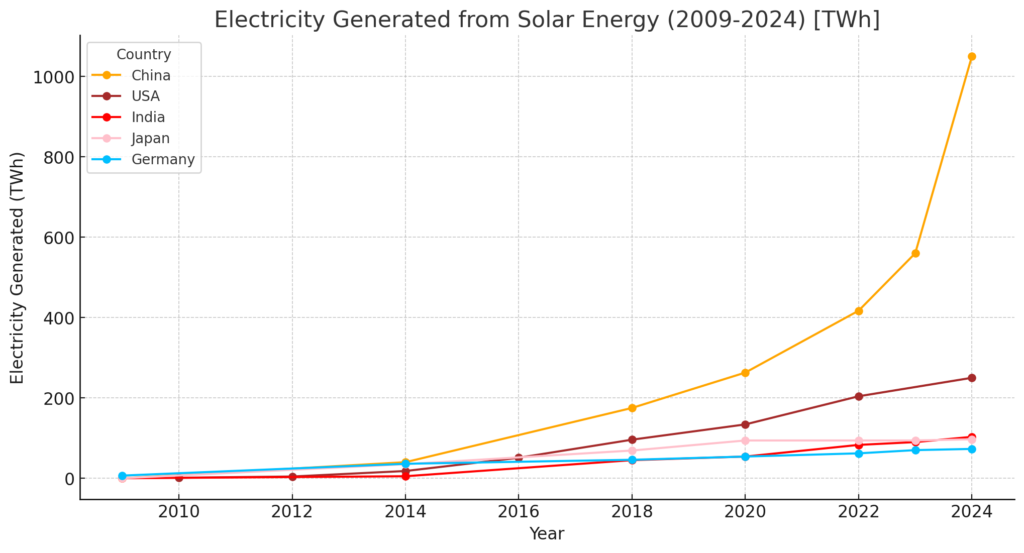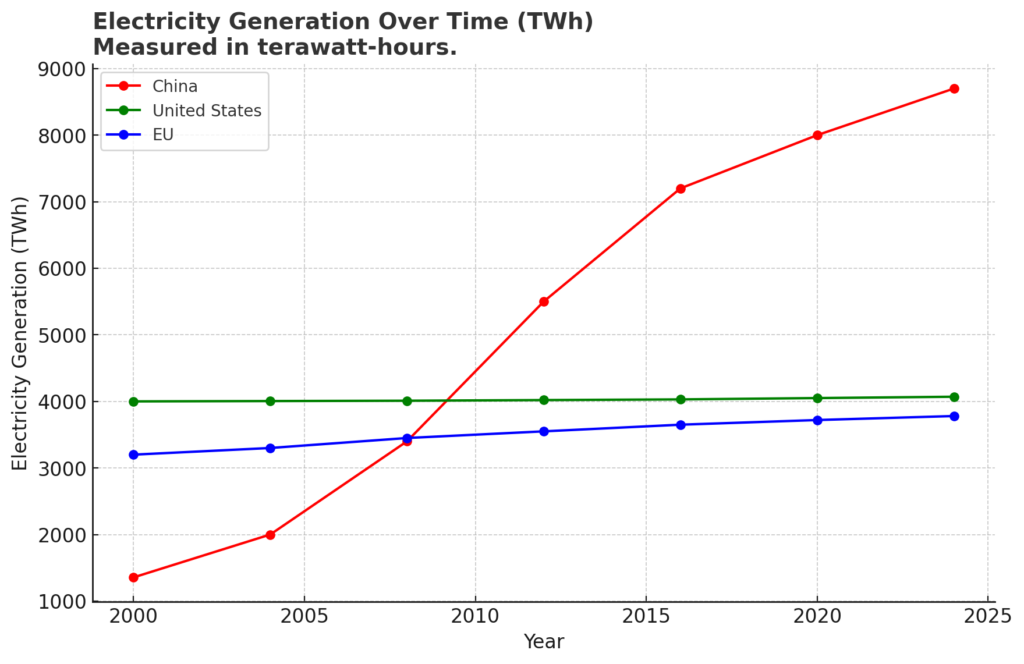As the energy transition accelerates, one thing is clear: renewables—particularly solar—are the undisputed leaders in global energy growth. The latest data on solar electricity generation (2009-2024) reinforces this trend, showing that solar has outpaced all other forms of electricity generation by a wide margin.
This post builds on my previous analysis of the rise of renewables in China, as covered in:
The Energy Transition
Between 2009 and 2024, solar electricity generation skyrocketed globally, with China leading the charge.
China’s Solar-Powered Growth
- China’s rise is unparalleled—from near-zero in 2009 to an estimated 1,050 TWh in 2024, including both utility-scale and rooftop PV.
- This estimate is based on China’s cumulative installed capacity of 886 GW, with a 13–14% capacity factor, aligning with Ember, IEA, and NEA reports.
- China installed more solar in 2024 than the U.S. has in its entire history—securing its dominance in global solar output.
How Other Nations Compare
- U.S. Solar: In 2024, the United States generated an estimated 275-280 TWh of solar electricity, up from 204 TWh in 2023, marking a 34.8-37.3% increase in total solar generation. This surge was driven by a record-breaking 50 GW of new solar capacity added—21% more than in 2023—making it the second consecutive year of record solar installations. Solar and storage together accounted for 84% of all new electricity generation capacity, further solidifying renewables as the dominant force in the U.S. energy transition.
- In 2024, India, Japan, and Germany are projected to achieve significant solar electricity generation:
- India: Expected to generate approximately 130 TWh of solar electricity, reflecting its rapid expansion in solar capacity.
- Japan: Anticipated to produce around 97 TWh from solar energy, maintaining its strong commitment to renewable sources.
- Germany: Projected to generate about 61 TWh of solar electricity, underscoring its ongoing dedication to sustainable energy solutions.
Collectively, these three nations are expected to contribute approximately 288 TWh of solar electricity in 2024, highlighting their leadership in global solar energy adoption.
This substantial output underscores the accelerating shift towards renewable energy, with solar power playing a pivotal role in reducing carbon emissions and promoting sustainable development worldwide.

Solar vs. Nuclear: The Shift
Solar is not just growing—it’s overtaking legacy energy sources.
Nuclear’s Stagnation
- Global nuclear energy output has remained flat (~2,650 TWh) since 2000, while global electricity demand doubled.
- Nuclear’s share fell from 16.6% in 2000 to ~9.1% in 2023—confirming that it is not keeping pace with demand.
- Solar is on track to surpass nuclear in 2025, driven by:
- Solar PV reaching ~2,170 TWh in 2024, a 33% YoY increase.
- A projected 2,800 TWh in 2025, exceeding nuclear for the first time.
The Policy Paradox
While solar’s rise is market-driven, targeted policies accelerated deployment, especially in China and the U.S.
Policy Superchargers the Market
Solar’s explosive growth has primarily been driven by declining costs and technological advancements, but smart government interventions have played a critical role in expediting the transition. Without these targeted policies, the adoption curve would have been far slower, allowing fossil fuels and nuclear to retain a stronger foothold.
China’s Command Approach
China’s rapid scale-up of solar is a direct result of its long-term planning. The government actively supports the solar industry through:
- The 14th Five-Year Plan: Prioritized renewable energy expansion, mandating aggressive solar and wind deployment.
- State-Owned Enterprises (SOEs): Massive infrastructure investments from state-backed firms.
- Solar Manufacturing Subsidies: Direct incentives for domestic production, leading to China’s dominance in the global solar supply chain.
- Grid Expansion & Storage: Heavy investment in high-voltage transmission lines and battery storage to integrate renewables more efficiently.
The U.S. Market-First
Unlike China’s centralized planning, the U.S. solar boom has been fueled by a mix of federal incentives and private sector investment. Key policies include:
- The Inflation Reduction Act (IRA): Unlocking billions in tax credits for solar installations, manufacturing, and battery storage.
- State-Level Mandates: Policies like California’s rooftop solar requirement and Renewable Portfolio Standards (RPS) have pushed adoption.
- Net Metering & Tax Incentives: Reducing the cost of solar for homeowners and businesses.
EU’s Efficiency-Focused Strategy
The European Union, while not scaling up solar as aggressively as China, has implemented:
- Carbon Pricing Mechanisms: Making fossil fuels less competitive and boosting renewables.
- Feed-in Tariffs & Auctions: Early-stage subsidies that helped solar become cost-competitive.
- Grid Modernization Investments: Expanding cross-border electricity sharing to balance solar output.
Market Leads, Policy Accelerates
The global solar boom is undeniably market-driven, but governments have provided the conditions for faster deployment and integration. The key takeaway? When market forces and policy align, the transition accelerates exponentially.
China’s 5-Year Plan & U.S. Incentives
- China’s 14th Five-Year Plan prioritized renewables, pushing aggressive infrastructure expansion.
- The U.S. Inflation Reduction Act (IRA) unlocked tax credits that doubled solar investments in 2023–2024.
While markets drive the transition, policy plays a supporting role—helping to scale manufacturing, deployment, and grid integration faster.
Why Nuclear Can’t Compete
While nuclear provides steady baseload power, its drawbacks make it uncompetitive in most scenarios:
- High Costs & Long Timelines: Nuclear takes decades to build and is 4–5x more expensive than solar.
- Grid Adaptability: Solar + battery storage is faster, cheaper, and more scalable than nuclear.
- Market Forces: Falling costs and rapid deployment favor solar, with nuclear struggling to attract investment.
With solar’s storage solutions improving, nuclear’s role is shrinking globally—except in niche applications.
Final Thoughts
China’s rapid shift toward renewable energy is reshaping global geopolitics, challenging traditional energy dependencies and redefining economic alliances. Beyond its dominance in solar and wind power, no other nation has expanded its energy sector as much overall, reinforcing its position as the world’s energy powerhouse. This transformation is not only accelerating the transition away from fossil fuels but also shifting the balance of power in global energy markets. The impact is already evident, with a noticeable drop in oil demand signaling the beginning of a deeper structural shift that is influencing trade, policy decisions, and the strategic positioning of energy-dependent nations.
- China’s electricity demand surged 6.5x since 2000, cementing its role as the world’s largest producer and consumer of energy.
- The U.S. and EU are not rapidly expanding their total electricity supply; instead, they are prioritizing efficiency gains and reducing consumption, a strategy that leans more toward stagnation than growth.
The Market Decides:
The energy transition is unfolding at a pace beyond the control of any government, driven by the relentless advancement of technology and the undeniable economics of renewables. Solar power, in particular, is dominating not because of political mandates but due to its rapidly declining costs, scalability, and ability to outcompete fossil fuels and nuclear on price and deployment speed. Market forces are dictating the shift, as businesses and consumers increasingly opt for the most cost-effective and efficient energy solutions. Governments may attempt to shape policy or slow certain aspects of the transition, but the sheer momentum of technological progress and economic incentives ensures that solar’s rise is inevitable.
🚀 Will nuclear stage a comeback, or is solar the undisputed future of energy? Share your take below! – Bluesky Comments

Related Reads:
What’s Next?
🔹 Solar’s impact in developing nations
🔹 How storage & AI will transform grid management
🔹 The next trillion-dollar energy disruptor?
Stay tuned! ⚡🌍

